Hiroyuki Uga
Towards Robust Plant Disease Diagnosis with Hard-sample Re-mining Strategy
Sep 05, 2023Abstract:With rich annotation information, object detection-based automated plant disease diagnosis systems (e.g., YOLO-based systems) often provide advantages over classification-based systems (e.g., EfficientNet-based), such as the ability to detect disease locations and superior classification performance. One drawback of these detection systems is dealing with unannotated healthy data with no real symptoms present. In practice, healthy plant data appear to be very similar to many disease data. Thus, those models often produce mis-detected boxes on healthy images. In addition, labeling new data for detection models is typically time-consuming. Hard-sample mining (HSM) is a common technique for re-training a model by using the mis-detected boxes as new training samples. However, blindly selecting an arbitrary amount of hard-sample for re-training will result in the degradation of diagnostic performance for other diseases due to the high similarity between disease and healthy data. In this paper, we propose a simple but effective training strategy called hard-sample re-mining (HSReM), which is designed to enhance the diagnostic performance of healthy data and simultaneously improve the performance of disease data by strategically selecting hard-sample training images at an appropriate level. Experiments based on two practical in-field eight-class cucumber and ten-class tomato datasets (42.7K and 35.6K images) show that our HSReM training strategy leads to a substantial improvement in the overall diagnostic performance on large-scale unseen data. Specifically, the object detection model trained using the HSReM strategy not only achieved superior results as compared to the classification-based state-of-the-art EfficientNetV2-Large model and the original object detection model, but also outperformed the model using the HSM strategy.
LASSR: Effective Super-Resolution Method for Plant Disease Diagnosis
Oct 12, 2020Abstract:The collection of high-resolution training data is crucial in building robust plant disease diagnosis systems, since such data have a significant impact on diagnostic performance. However, they are very difficult to obtain and are not always available in practice. Deep learning-based techniques, and particularly generative adversarial networks (GANs), can be applied to generate high-quality super-resolution images, but these methods often produce unexpected artifacts that can lower the diagnostic performance. In this paper, we propose a novel artifact-suppression super-resolution method that is specifically designed for diagnosing leaf disease, called Leaf Artifact-Suppression Super Resolution (LASSR). Thanks to its own artifact removal module that detects and suppresses artifacts to a considerable extent, LASSR can generate much more pleasing, high-quality images compared to the state-of-the-art ESRGAN model. Experiments based on a five-class cucumber disease (including healthy) discrimination model show that training with data generated by LASSR significantly boosts the performance on an unseen test dataset by nearly 22% compared with the baseline, and that our approach is more than 2% better than a model trained with images generated by ESRGAN.
LeafGAN: An Effective Data Augmentation Method for Practical Plant Disease Diagnosis
Feb 24, 2020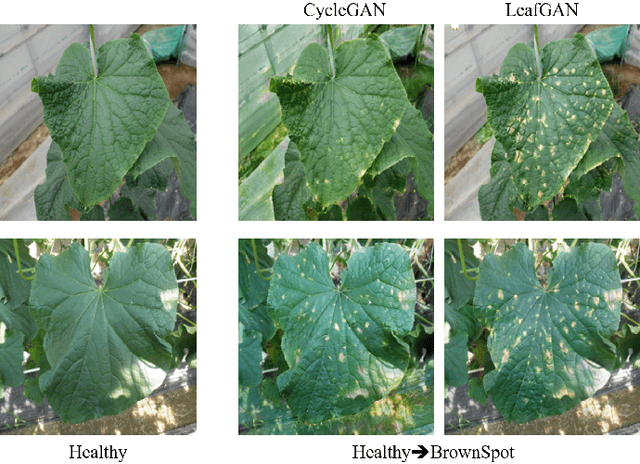
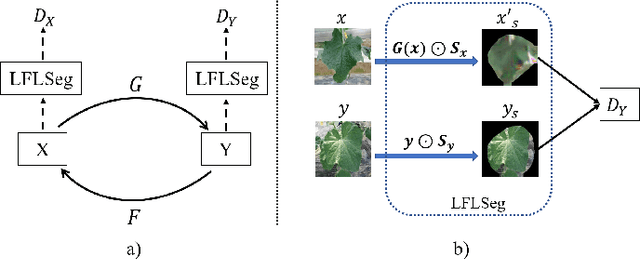

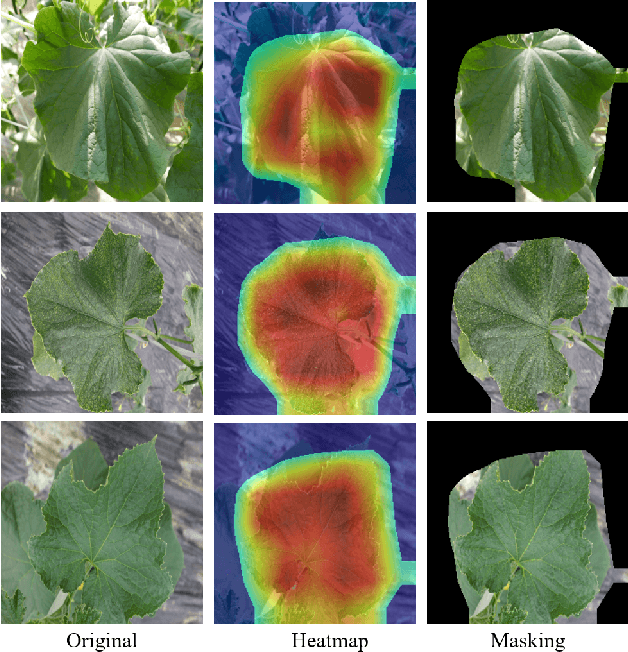
Abstract:Many applications for the automated diagnosis of plant disease have been developed based on the success of deep learning techniques. However, these applications often suffer from overfitting, and the diagnostic performance is drastically decreased when used on test datasets from new environments. The typical reasons for this are that the symptoms to be detected are unclear or faint, and there are limitations related to data diversity. In this paper, we propose LeafGAN, a novel image-to-image translation system with own attention mechanism. LeafGAN generates a wide variety of diseased images via transformation from healthy images, as a data augmentation tool for improving the performance of plant disease diagnosis. Thanks to its own attention mechanism, our model can transform only relevant areas from images with a variety of backgrounds, thus enriching the versatility of the training images. Experiments with five-class cucumber disease classification show that data augmentation with vanilla CycleGAN cannot help to improve the generalization, i.e. disease diagnostic performance increased by only 0.7% from the baseline. In contrast, LeafGAN boosted the diagnostic performance by 7.4%. We also visually confirmed the generated images by our LeafGAN were much better quality and more convincing than those generated by vanilla CycleGAN.
Super-Resolution for Practical Automated Plant Disease Diagnosis System
Nov 26, 2019



Abstract:Automated plant diagnosis using images taken from a distance is often insufficient in resolution and degrades diagnostic accuracy since the important external characteristics of symptoms are lost. In this paper, we first propose an effective pre-processing method for improving the performance of automated plant disease diagnosis systems using super-resolution techniques. We investigate the efficiency of two different super-resolution methods by comparing the disease diagnostic performance on the practical original high-resolution, low-resolution, and super-resolved cucumber images. Our method generates super-resolved images that look very close to natural images with 4$\times$ upscaling factors and is capable of recovering the lost detailed symptoms, largely boosting the diagnostic performance. Our model improves the disease classification accuracy by 26.9% over the bicubic interpolation method of 65.6% and shows a small gap (3% lower) between the original result of 95.5%.
AOP: An Anti-overfitting Pretreatment for Practical Image-based Plant Diagnosis
Nov 25, 2019

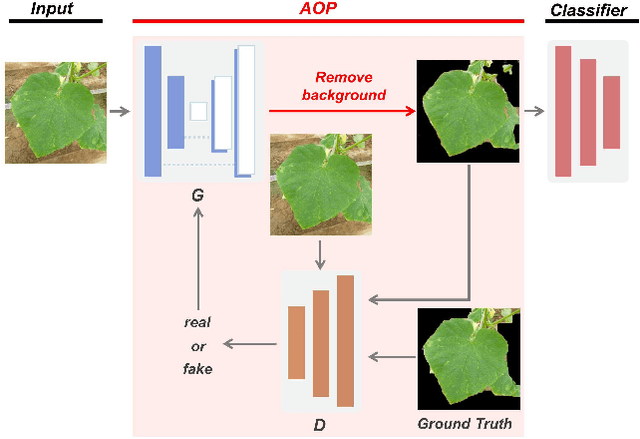
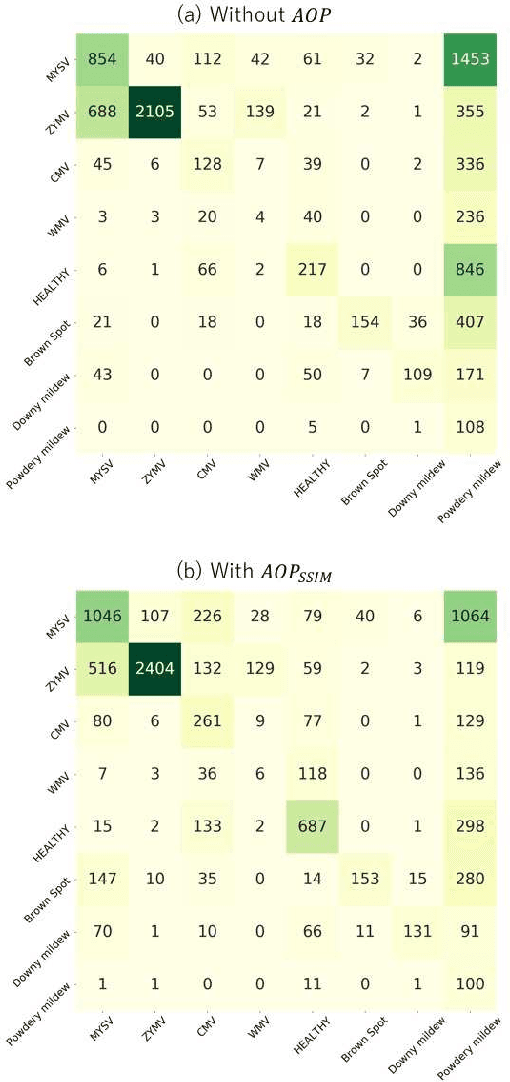
Abstract:In image-based plant diagnosis, clues related to diagnosis are often unclear, and the other factors such as image backgrounds often have a significant impact on the final decision. As a result, overfitting due to latent similarities in the dataset often occurs, and the diagnostic performance on real unseen data (e,g. images from other farms) is usually dropped significantly. However, this problem has not been sufficiently explored, since many systems have shown excellent diagnostic performance due to the bias caused by the similarities in the dataset. In this study, we investigate this problem with experiments using more than 50,000 images of cucumber leaves, and propose an anti-overfitting pretreatment (AOP) for realizing practical image-based plant diagnosis systems. The AOP detects the area of interest (leaf, fruit etc.) and performs brightness calibration as a preprocessing step. The experimental results demonstrate that our AOP can improve the accuracy of diagnosis for unknown test images from different farms by 12.2% in a practical setting.
A comparable study: Intrinsic difficulties of practical plant diagnosis from wide-angle images
Nov 22, 2019
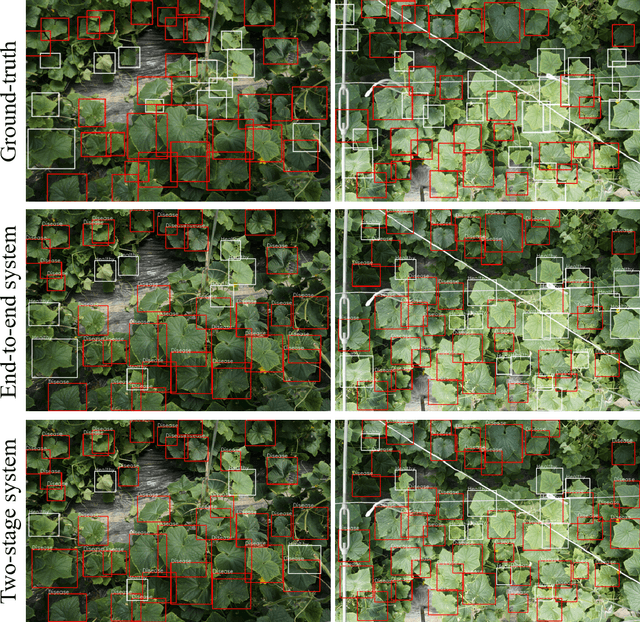
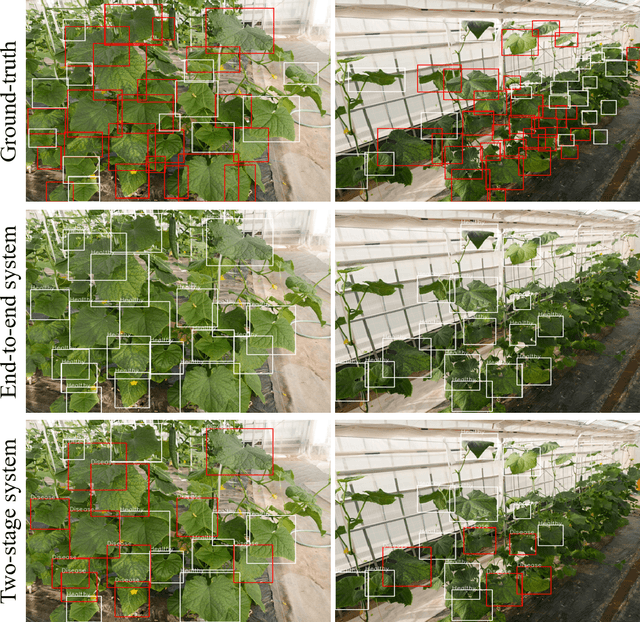

Abstract:Practical automated detection and diagnosis of plant disease from wide-angle images (i.e. in-field images containing multiple leaves using a fixed-position camera) is a very important application for large-scale farm management, in view of the need to ensure global food security. However, developing automated systems for disease diagnosis is often difficult, because labeling a reliable wide-angle disease dataset from actual field images is very laborious. In addition, the potential similarities between the training and test data lead to a serious problem of model overfitting. In this paper, we investigate changes in performance when applying disease diagnosis systems to different scenarios involving wide-angle cucumber test data captured on real farms, and propose an effective diagnostic strategy. We show that leading object recognition techniques such as SSD and Faster R-CNN achieve excellent end-to-end disease diagnostic performance only for a test dataset that is collected from the same population as the training dataset (with F1-score of 81.5% - 84.1% for diagnosed cases of disease), but their performance markedly deteriorates for a completely different test dataset (with F1-score of 4.4 - 6.2%). In contrast, our proposed two-stage systems using independent leaf detection and leaf diagnosis stages attain a promising disease diagnostic performance that is more than six times higher than end-to-end systems (with F1-score of 33.4 - 38.9%) on an unseen target dataset. We also confirm the efficiency of our proposal based on visual assessment, concluding that a two-stage model is a suitable and reasonable choice for practical applications.
 Add to Chrome
Add to Chrome Add to Firefox
Add to Firefox Add to Edge
Add to Edge